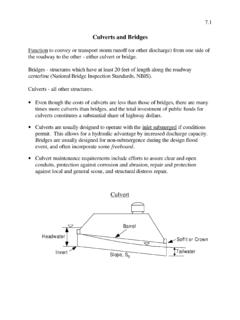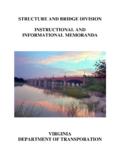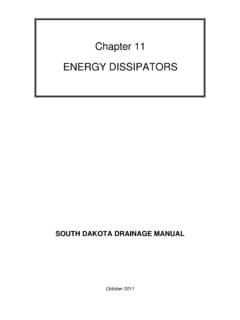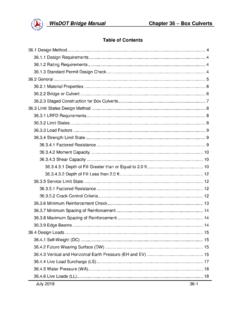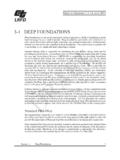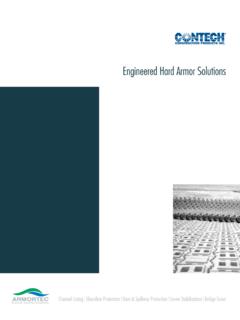Transcription of Fabriform
1 Fabriform REVETMENTS PILE JACKETS. Tailored Solutions for Concrete CONCRETE BAGS.. WHAT IS FABRIC FORMED CONCRETE? Fabric-formed concrete is the result of pumping a highly fluid concrete mix into specially woven fabric envelopes. This method of erosion-control allows for fast, economical construction of revetments, landfill containment systems, holding ponds, bridge scour repair, bridge or dock piling reinforcement and countless other applications. This innovative technique utilizes fabric woven of high tenacity nylon yarn into a variety of forms including mats, pile jackets and bags. At the work site, the custom-made forms are positioned and sewn together with hand-held sewing machines. They are then pumped with fine aggregate concrete and allowed to cure. Fabric-formed concrete eliminates the need for time-consuming wooden forms.
2 Plus, fabric forms have the unique advantage of allowing the concrete to be pumped and cured below the water line making site preparation much easier. Labor and mate- rial costs are reduced due to simpler installation and more efficient use of concrete. This efficiency makes fabric-formed con- crete budget-friendly by design. In addition to economical advantages, fabric-formed concrete is the smart choice for erosion control because of its high versa- tility, durability and effectiveness. Worldwide, there are millions of square feet of fabric-formed concrete in place. WHY CHOOSE Fabriform ? Fabriform is the original fabric-formed concrete system. The Fabriform system was developed and patented by Construction Techniques in the mid-1960's. Forty years later, Construction Techniques continues to manufacture Fabriform to the highest standards of quality.
3 Not all fabric is created equal. The Fabriform system utilizes double-layer, high-tenacity nylon fabric, specially woven for opti- mum strength, stability, adhesion and filtering characteristics. These qualities are necessary to withstand pumping pressure during installation and to ensure resistance to the strong alkalis present in concrete. In addition to quality, Fabriform is a great value because it is manufactured in-house. That is, Construction Techniques oper- ates the mill that weaves and assembles the various styles of Fabriform . This not only ensures quality control, it helps control costs making high-quality Fabriform highly competitive. As the patent-holder of Fabriform , a pioneer in fabric-formed concrete systems, Construction Techniques is the most experienced and trusted name in the industry.
4 With over 100 years of combined experience in the sale, manufacture and service of Fabriform products, the staff of Construction Techniques is well-prepared to advise you on your next project. Allow us to put our experi- ence to work for you. THREE FABRIC STYLES FOR REVETMENTS: Filterpoint For maximum attenuation of hydraulic energy and relief of hydrostatic uplift. Filterpoint revetments are characterized by aesthetically appealing cobbled surfaces. Woven filterpoints (5", 8" or 10" centers when cast-in-place) between cobbles relieve hydrostatic uplift pressure and each revetment exhibits a high coefficient of hydraulic fric- tion. The majority of erosion control applications utilize the 8" (200mm) filterpoint revet- ment. The light 5" (130mm) filterpoint style fabric is available for constructing thinner revetments in less demanding areas such as the shorelines for small ponds and drainage ditches.
5 The 10" (250mm) filterpoint provides a heavy duty mat when severe abrasion is anticipated or additional weight is advisable. Unimat For minimum hydraulic friction and maximum impermeability. Unimat revetments are characterized by a slightly dimpled surface. These revetments exhibit a relatively low coefficient of hydraulic friction. Permeability approximates that of high quality concrete paving. Unimat style fabric for construction of 3" (75mm), 4" (100mm). and 6" (150mm) thick revetments is carried in inventory. Fabric for other revetments from 8" (200mm), 10" (250mm) and 12" (300mm) thickness is available on special order. Criteria for selection of unimat revetment is the same as that employed in determining the thick- ness of concrete paving. Articulating Block For slopes subject to severe underscour or consolidation.
6 AB revetments consist of rectangular concrete blocks cast in place in a staggered pattern and can be linked together by reinforcing cables inserted between the two layers of fab- ric prior to mortar injection. Cables allow the revetment to articulate with changing soil and water conditions. AB style fabrics for construction of an average 4" (100mm), 6". (150mm) and 8" (200mm) thickness are carried in inventory. If required, nylon rope cables in sizes to meet design requirements are installed in the assembled panels. All Fabriform fabrics are manufactured with 100% continuous multifilament, high-tenacity nylon for stability and resistance to the strong alkalis present in concrete and are woven such that at least 50% by weight consists of tex- tured fibers for optimum filtering characteristics and adhesion to mortar.
7 Concrete Bags Fabric forms to solve tough concrete forming problems. Fabriform Concrete Bags are the most versatile concrete forming system available. Retaining Walls, Spillways, Pipe Saddles or void/cavity forms on any volume are just a few of the applications for Concrete Bags. Construction Techniques custom tailors all Bags to accommodate required dimensions. As with all Fabriform processes, Concrete Bags can be cast underwater as well as in the dry. 1 Bridge Re-Bars 2 Pier Filter Cloth Cavity Groins Shoreline protection Pipeline saddles Structural cavity repairs Breakwaters Pile Jackets Zippered fabric forms for marine pile repair. Fabriform Pile Jackets are a strong lightweight concrete form used in marine pile rehabilitation. Jackets are custom assembled to project requirements to fit any length and size of steel, timber or concrete piles.
8 Pile jackets lower production costs in three ways: 1) Preassembled, no form fabrication required, 2) Easy to handle, requires no lifting equipment and 3) Forms bleed excess mixing water. A lower water/cement ratio provides exceptional concrete durability. CONTACT INFORMATION. With over 100 years of combined experience in the sale, manufacture and service of Fabriform products, the staff of Construction Techniques is well-prepared to advise you on your next project. Allow us to put our experience to work for you. For more information, contact us today or visit our website. ADDRESS 15887 Snow Road, Suite 100 TELEPHONE / Box 42067 FACSIMILE Cleveland, Ohio 44142, USA EMAIL WEBSITE a product of: ConstructionTechniques INCORPORATED. 2003 Construction Techniques, Inc. The Fabriform name and logo are registered trademarks of Construction Techniques, Inc.
9 All rights reserved.
